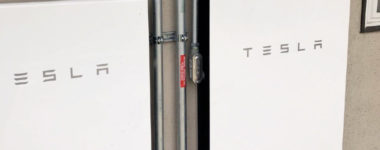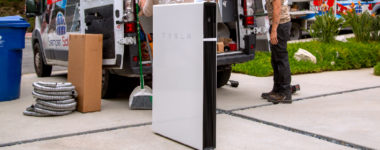Tesla Powerwall | Solar Panels, Battery Storage, Roofing, HVAC
Extreme weather events are inevitable no matter where you live. Recently, the normally mild state of Texas experienced the arrival of a harsh winter storm that brought unusually frigid temperatures, snow, and ice. A power outage only compounded the effects of this cold weather disaster. In California, residents frequently struggle with extreme weather that is opposite to what has been afflicting Texans: dangerous, out-of-control wildfires that lead to extensive power outages. Florida also repeatedly sees vicious storms and hurricanes that wipe out electricity for days on end. During the extreme weather that so many states across the country have been experiencing in the past decade, the importance of having a reliable solar energy storage system is more important than ever. There is nothing quite as dangerous as losing the ability to heat your home in chilling, subzero conditions, or the lack of air conditioning during hot, stifling weather. Independence from conventional power sources is currently one of the few ways to navigate the challenges that power failures bring. This is where the importance of an alternative energy source comes in. Rooftop solar panels and the Tesla Powerwall together serve as a viable solution. The costs of installing an alternative energy system can seem steep at first glance. However, the price is more than worth it when it comes to saving money on electricity and having access to power during an outage. Even during non-emergencies, the ability to reduce an expensive electric bill is always a plus. Solar panels gather energy from the sun throughout the day, while the Tesla Powerwall serves as solar batter storage that you can utilize to accumulate energy for nighttime use or for a time that you truly need it. Depending on the solar panel company, these alternative energy systems can last from anywhere between 10 and 25 years before a replacement is due. Most companies offer 10-year, 25-year, or more warranties just in case of any premature malfunctions. The Tesla Powerwall is an excellent addition to most types of solar energy system, including the Silfab, Q-Cells, Tesla Solar Roof or power system. Powerwalls from Tesla have an energy usage capacity of 13.5 kWh and come with a 10-year warranty. The Tesla Powerwall is also easy to program so that it will automatically switch to stored power during the night or the moment the electricity goes down during a storm. Temperature resilience is another added benefit to these Powerwalls, which makes them suitable for most hot to moderate climates if you choose to install them outside. They function in temperatures as high as 122 degrees Fahrenheit (50 degrees Celsius) and as low as minus 4 degrees Fahrenheit (minus 20 degrees Celsius). Depending on individual homeowners' budgets or household needs, anywhere from one to several installed Powerwalls could be necessary. For the average household, it is better to install two Tesla Powerwalls than one. A single Powerwall restricts energy to minor, low consumption functions such as outlets, power circuits, and lights. A double Powerwall installation is more suitable for most homes so that appliances that take up more energy can also receive enough power to function. With two Powerwalls instead of one, your electricity use can go on as usual during an outage without the need to reduce energy usage to bare necessities. Depending where you live, a snowstorm, hurricane, wildfire, or other unanticipated event of severe weather could kill your power for several days and leave you without running water, heat, or air conditioning. This is not only inconvenient, it is potentially deadly if you are unable to warm or cool your home during extreme temperatures. With the rapidly heating global climate, unusual weather events have continued to increase around the world. The Tesla Powerwall combined with a rooftop solar energy system provides homeowners with a self-sustaining energy source that will keep the lights on during even extended power outages. With sky-high power bills and reoccurring storms or fires, green alternative energy sources can save you a lot of money and inconvenience. While the costs of a solar energy system in addition to a couple of Powerwalls costs several thousand dollars, the price is well worth it when it comes to being able to keep your power on during unavoidable natural disasters.
Several years ago, Elon Musk steered Tesla Motors into the renewable energy market with an innovative home energy storage product – Tesla Powerwall. This home battery is designed with the same dedication to detail and innovation as Tesla’s cutting-edge electric vehicles and other ventures. While Tesla certainly didn’t invent solar storage batteries, they certainly used their reputation as a leading-edge tech and renewable energy-conscious company to launch their Powerwall into a mostly untapped market. With Tesla’s stamp of approval, new buzz and interest have surrounded the prospect of storing solar energy created by a home’s solar panels. So what exactly is the Powerwall? According to Tesla, it is a small-scale rechargeable lithium ion battery that provides homeowners with more access to self-sustaining energy for their homes Understanding Tesla Powerwall These batteries are designed for optimal use with a solar panel system. How does having the Powerwall installed change the game for homeowners with solar panels? It gives them much more independence from the grid when it comes to energy needs during low production times. Essentially, the Powerwall allows a homeowner to fully control their electricity production and usage by storing home energy for later use. As would be expected, Tesla spent a significant amount of time and energy developing the Powerwall into a reliable, effective home battery for regular use. The battery works by storing any excess electricity your solar panels produce vs. allowing that electricity to be sent back to the grid (usually for a credit in most states). Even in states with a credit, homeowners are still technically “buying” electricity from the grid when their panels don’t produce electricity at certain times. The battery allows any surplus to be stored and used during these times rather than grid dependency. While a single Powerwall battery won’t enable you to go completely “off the grid,” it does allow you much more freedom and starts to transition your home towards being much more self-sufficient. How Long Will Tesla Powerwall Last? Tesla backs it Powerwall up with a completely unlimited 10-year warranty. This warranty covers daily charging and usage, so essentially as much wear and tear as possible. The warranty also guarantees that a home’s Powerwall will maintain a minimum of 70% of its full charge capacity over this time. It is typical for batteries to lose some of their ability to maintain a charge with usage. Is Tesla Powerwall Right for Your Home? Adding a solar battery to a home solar panel system isn’t right for everyone. Further, solar batteries are still pretty new to the market, meaning the technology will continue to improve with time. If you have a utility system that provides net metering for solar panel owners, a solar battery may not be as necessary. In comparison, homeowners in areas that enforce time-of-use rates for electricity would be wise to consider investing in a solar battery to curb their expenses. Finding out if a solar battery is a good investment for your home starts with talking to a solar expert. Semper Solaris is a Tesla Powerwall certified installer and can answer any questions you have about Tesla Powerwall or similar solar energy batteries.

